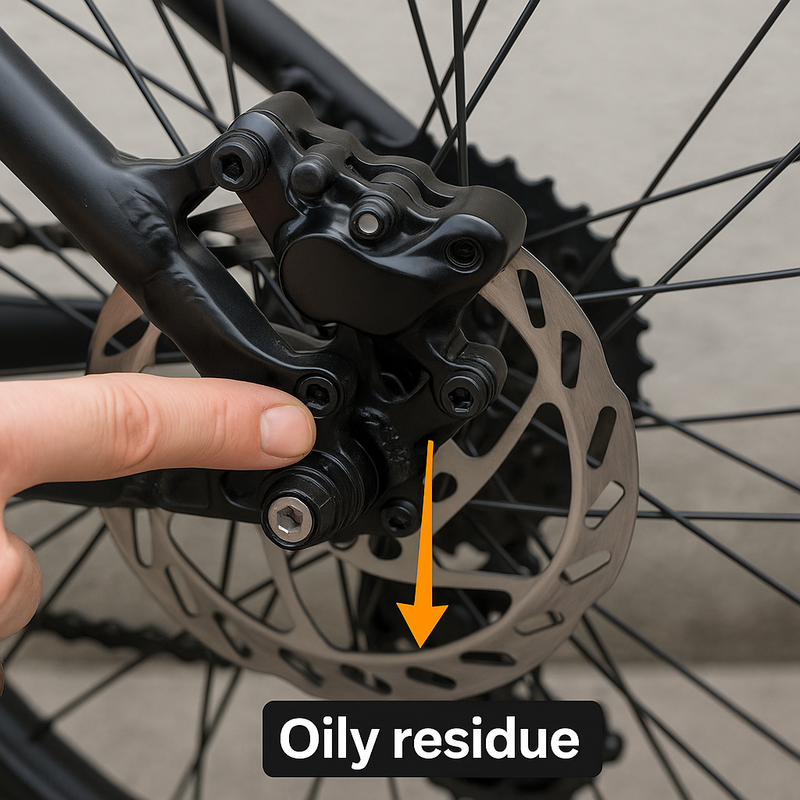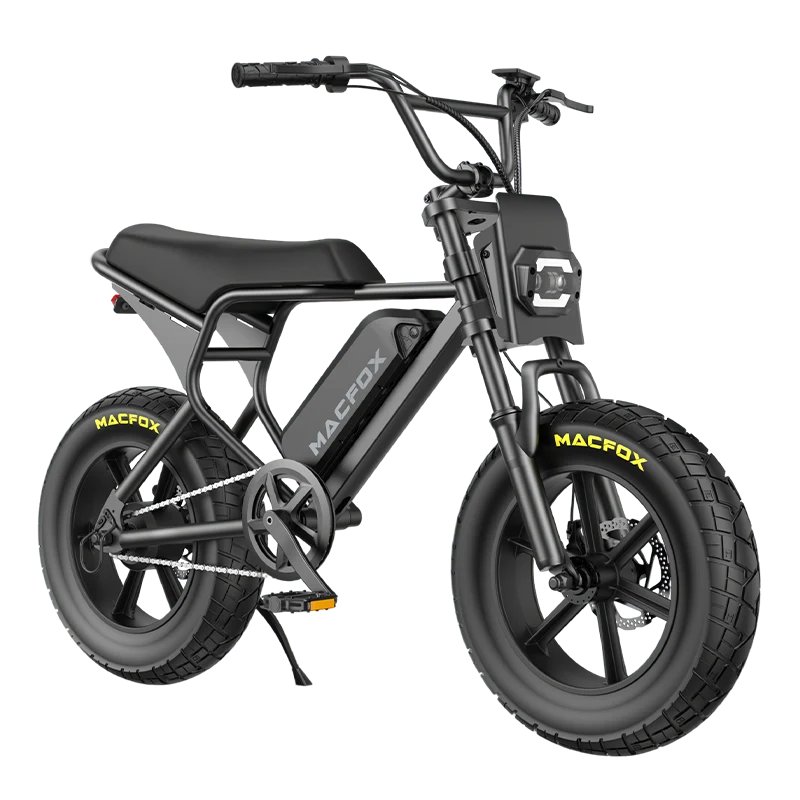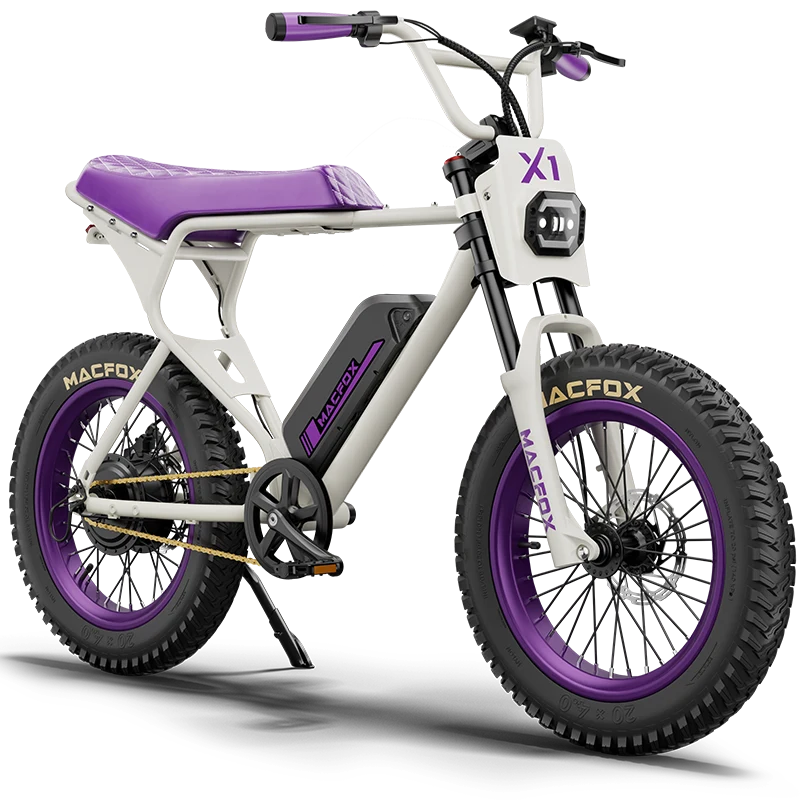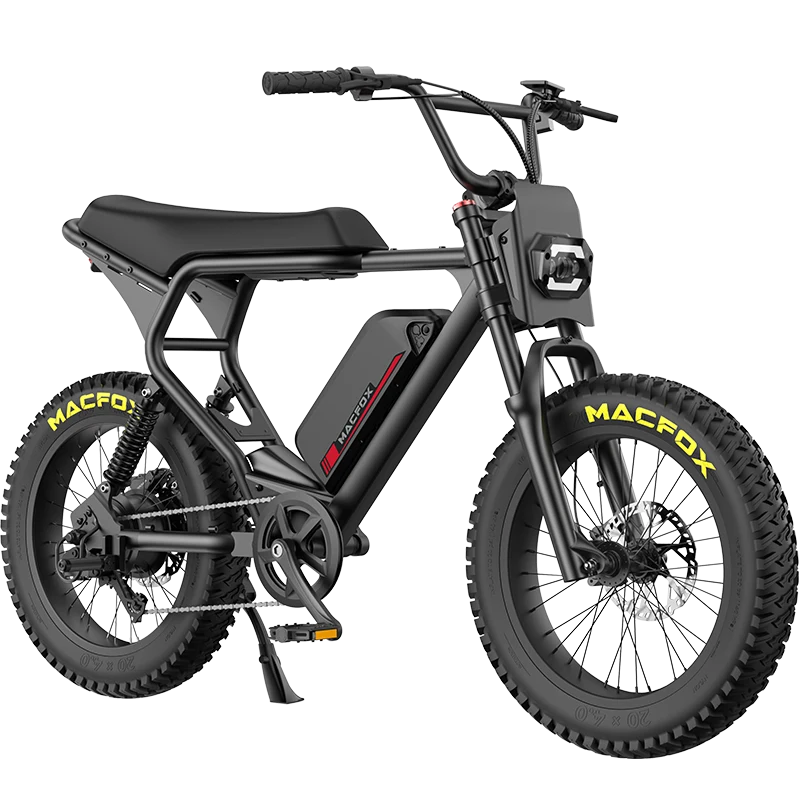If you discover rear disc brake oil leakage on your electric bike, it’s critical to address it immediately. Oil (hydraulic brake fluid) leaking from the brake system will drastically reduce your braking power and compromise safety.
In this guide, we’ll explain why a hydraulic disc brake might leak, how to fix it, and steps to prevent it – so you can keep your e-bike’s brakes working reliably.
Quick Summary
-
Safety Impact: A leaking rear brake loses hydraulic pressure, resulting in weak or no braking power. This poses a serious safety risk and should be fixed immediately.
-
Common Causes: The most common causes of brake fluid leaks include worn seals, loose or damaged brake line fittings, cracked brake hoses, overfilled fluid reservoirs, corrosion on components, or faulty calipers.
-
Fixes: Solutions involve replacing damaged seals, tightening or swapping out leaky hoses and fittings, bleeding the brakes to remove air, and replacing any faulty components like a cracked caliper.
-
Prevention: Regular maintenance (frequently checking for leaks and wear), proper installation of quality parts, avoiding overheating the brakes, and protecting the bike from moisture will help prevent future leaks.
Understanding Rear Disc Brake Oil Leakage
Hydraulic disc brakes work by using fluid (often a special brake oil) to transfer force from the brake lever to the caliper. Oil leakage means this fluid is escaping the sealed system when and where it shouldn’t.
The leak can occur at various points – such as the brake caliper (at the piston seals or where the caliper halves join), the brake hose or its connections, or even at the brake lever’s master cylinder.
When fluid leaks out, the brake loses the pressure needed to push the pads firmly onto the rotor, resulting in a spongy brake feel or complete loss of braking. Moreover, leaking brake fluid can drip onto the rotor and pads, contaminating them.
Oil on the brake pads or rotor greatly reduces friction, meaning the brake will grab weakly or not at all.
In short, a brake fluid leak makes your rear brake far less effective (or even completely fails), which is extremely dangerous if not corrected.
Hydraulic brakes on e-bikes commonly use either mineral oil or DOT brake fluid. Both types should remain sealed inside the system.
If you see any wet, oily residue around your brake components or notice performance issues, it indicates something is wrong.
In the next sections, we’ll look at how to recognize a leak, what causes it, and how to fix it.
Related: Electric Bike Brakes Not Working? Here’s What You Can Do
Signs of a Leaking Rear Disc Brake

It’s not always obvious at first that your rear brake is leaking oil. Here are some telltale symptoms of a brake fluid leak:
Soft or Unresponsive Brake Lever
The brake lever might suddenly feel “mushy” or pull all the way to the handlebar with little resistance. This happens because fluid has leaked out or air has entered the line, preventing the hydraulic pressure from building up.
A soft lever is a strong warning sign – if you squeeze the lever and it sinks to the grip without much braking force, you likely have a leak or air in the system.
Reduced Braking Power
You may notice the rear brake isn’t as powerful as before or the bike takes longer to stop.
In severe cases, the rear brake can fail entirely. If the brake was working fine and suddenly loses effectiveness, a fluid leak could be the cause (since loss of fluid means loss of pressure to push the pads).
Visible Oil Residue
Inspect the rear brake caliper, rotor, and surrounding area.
If you see oily wetness on the caliper, around the brake line connections, on the rotor, or even splattered on the wheel rim, that’s a clear indication of brake fluid leakage.
Sometimes the oil is mixed with dirt, appearing as grimy wet spots. Also, check the brake lever area – although the rear brake’s fluid is mostly in the back, a leak at the lever (master cylinder) can drip fluid around the lever or down the frame.
Any unexpected oily film in these areas is cause for concern.
Contaminated Pads (Squealing or Poor Grip)
If oil gets on the brake pads or rotor, you might hear the brake squeal loudly or notice the brake grabs unevenly.
Often, an oil-soaked brake pad will lose nearly all its stopping power and must be replaced. If you remove the pads and find oil on the pad surfaces or the pad’s backing plate, it’s a sign that fluid has leaked onto them (either from the caliper piston or from elsewhere).
Fluid Level Drop
On some e-bike brake levers, you can see the brake fluid reservoir or a small sight window.
A sudden drop in the fluid level in the reservoir is another warning sign of a leak (though on many bicycle brakes the reservoir is tiny and not always visible).
If you’ve recently bled the brakes or topped up fluid and now it’s low again, suspect a leak.
Related: How Do Electric Bike Brakes Work? A Comprehensive Guide
How to Confirm the Leak
To be sure where the leak is coming from, you can perform a simple check.
-
First, clean the caliper, rotor, and surrounding areas thoroughly (use isopropyl alcohol or brake cleaner to remove all grime and old fluid). Then dry everything.
-
Next, press the brake lever firmly a few times to build pressure. Look closely at the caliper: check the seam where the two halves of the caliper join, around each piston, the bleed screw (often on the caliper top or side), and the hose connection point.
If you see fresh oil seeping out at any of these spots, you’ve identified the leak source. For example, oil appearing around the caliper body or between it and the brake pads could indicate a piston seal leak.
Oil near the hose fitting or bleed screw could mean those fittings are loose or their seals are compromised.
-
Also examine the brake hose along its length for any wet spots or cracks.
By systematically checking these areas, you can pinpoint the faulty component. Once you know the source, avoid riding the bike until it’s fixed – and clean off any leaked fluid (it’s mildly corrosive and can ruin paint or attract dirt).
Common Causes of Rear Disc Brake Oil Leakage
There are several reasons why a hydraulic disc brake on an e-bike might start leaking fluid. Understanding these causes will help you address the problem and prevent it from happening again.
Here are the most common causes of rear brake oil leakage:
1. Worn or Damaged Seals

Inside the brake system, rubber seals keep the fluid contained (for instance, around the caliper pistons and inside the brake lever/master cylinder).
Over time, these seals can wear out, crack, or become brittle – especially with heavy use or age.
When a seal doesn’t do its job, fluid can escape past it. For example, the seals around the brake caliper pistons are a frequent culprit: after countless brake applications, they may eventually leak.
Likewise, the O-ring seals in the brake lever’s piston can fail. In some cases, pushing the brake pads far past their wear limit (so the pistons over-extend) can also cause seals to leak or pistons to weep fluid.
Worn seals are one of the top causes of brake leaks. If you notice fluid around the caliper or inside the lever without any external damage, a tired seal is likely to blame. (Water contamination inside the brake can accelerate seal deterioration by causing internal corrosion.)
2. Loose or Leaky Brake Line Fittings
Your brake hose (the flexible tubing carrying fluid to the rear caliper) is connected at each end by fittings.
At the caliper end, there may be a banjo bolt or threaded connector; at the lever, there’s usually a connector into the master cylinder.
If these brake line fittings are even slightly loose, fluid can seep out around them. Vibration from riding can gradually loosen a fitting, or an improper installation might not have tightened it enough.
A damaged olive or compression fitting (common on bicycle brakes) can also cause leaks at the hose joint. Signs of this cause include fluid specifically around the hose connection or down the brake line.
In some cases, the bleed screw (bleed nipple) on the caliper might be the source if it wasn’t closed properly or its threads are stripped – this also counts as a “fitting” leak.
Fortunately, if caught early, many fitting leaks can be solved by carefully tightening the connection with the correct tool (usually an Allen key or wrench). Be cautious not to over-tighten though, as that can strip threads or crush components.
If the leak persists, the fitting hardware (olive/banjo bolt or bleed screw) may need new seals or replacement.
3. Overfilled Brake Fluid Reservoir
While it may sound odd, putting too much fluid in the brake system can cause leaks.
If the brake’s reservoir (often integrated into the lever) was overfilled during service, it leaves no room for fluid expansion.
As brakes heat up during use (from friction), the fluid expands. With nowhere to go, the excess pressure forces fluid out of any weak point.
An overfilled reservoir can thus lead to leaks at the caliper seals or other connections when the fluid heats and expands. This is why manufacturers specify a correct fluid level.
If your leak started soon after a brake bleed or fluid top-up, and there’s no other apparent damage, an overfilled system could be the cause.
The solution is to bleed out the excess fluid until it’s at the proper level. Always leave a tiny air gap in the reservoir as specified – it allows the fluid to safely expand when hot.
Related: E-Bike Brake Upgrade: Mechanical to Hydraulic
4. Damaged Brake Hose or Line
The brake hose itself can be a source of the leak if it gets compromised. These hoses are designed to handle high pressure, but they aren’t indestructible. A cracked or punctured brake hose will let fluid leak out along its length.
This can happen due to: abrasion (rubbing against the bike frame or other object causing wear-through over time), impact or crash damage (something hitting or cutting the hose), or simply a manufacturing defect.
Additionally, bending the hose too sharply can weaken it. If you see a wet spot or crack on the hose itself (not just at the ends), that indicates hose damage.
In such cases, the hose must be replaced – it’s not feasible to patch a high-pressure hydraulic hose. Replace it with a new hose compatible with your brake model, and be sure to route and secure it properly to avoid future damage.
5. Corrosion on Brake Components
Riding in the rain, through mud, or storing your bike in damp conditions can take a toll on the brake system.
Corrosion or rust on metal brake parts can lead to leaks in a couple of ways. First, corrosion can eat away at metal surfaces, potentially ruining the smooth finish where a seal sits, thus preventing a proper seal.
For example, pitting on a caliper piston or cylinder due to corrosion can let fluid bypass the seal. Second, corrosion can freeze or damage moving parts (like pistons), causing abnormal wear on seals or even cracking.
Connectors and fittings can also corrode and develop leaks. If your bike’s brake components have visible rust or white corrosion (for aluminum), and you experience leaks, it’s likely the corrosion has compromised the integrity of a seal or part.
Preventing this cause is best: after wet or winter rides, try to clean and dry your bike.
In the case of existing corrosion, affected parts may need replacement or at least thorough cleaning. Regularly cleaning the brake and using corrosion inhibitors (when appropriate) can help.
In summary, keeping your brake system clean and dry when possible will ward off this cause of leaks.
6. Faulty or Cracked Brake Caliper

Sometimes the brake caliper unit itself is the issue. A manufacturing defect or a crack in the caliper body can allow fluid to escape.
For instance, a hairline crack in the caliper (possibly from a crash or overtightening a mounting bolt) might open up under pressure and leak fluid.
Additionally, the caliper houses the pistons – if the caliper bore is damaged or the pistons are scored, leaks can occur around them.
A faulty brake caliper could also refer to any internal issues where the caliper just isn’t holding pressure as it should. If you’ve tried replacing seals and checked fittings yet the caliper still leaks, the caliper might be warped or damaged beyond simple repair.
Inspect it closely for any signs of cracks or damage on the outside. Sometimes hairline cracks are hard to see – look especially near mounting points and around the bleed screw and hose connection.
The only cure for a cracked caliper is replacement (or professional repair if possible, but bike calipers are usually replaced).
The good news is that replacement calipers for many brake models are available and not overly expensive. Replacing a faulty caliper with a new or known-good unit will solve leaks coming from structural defects.
Related: Electric Bike Disc Brake Adjustment
7. Improper Installation or Maintenance
Finally, human error can be a cause. If the brake system was not installed correctly or has been serviced improperly, leaks can result.
For example, if the brake line was not cut cleanly or the fittings not attached per instructions, the joint may not seal.
Over- or under-tightening certain parts can also cause trouble. Improper maintenance like using the wrong type of brake fluid can deteriorate seals (e.g., putting DOT fluid in a system designed for mineral oil, or vice versa, will ruin rubber seals).
Skipping maintenance can be just as bad – never bleeding the brakes can allow old fluid to absorb water and corrode parts internally, leading to leaks over time.
In short, mistakes or neglect in setup can lead to leakage issues. Always follow manufacturer guidelines when installing or servicing brakes.
Use the correct fluid type and bleed kit, tighten components to specified torque, and ensure all parts (like washers or O-rings) are in place.
If you’re unsure, have a professional mechanic handle the installation. Good maintenance practices (like periodic brake bleeds and inspections) go a long way toward preventing leaks.
Inspecting a bicycle’s rear disc brake caliper for any oil leakage. Leaks often show up as shiny wet areas on or around the caliper (see arrow), indicating escaping brake fluid.
How to Fix a Rear Disc Brake Oil Leak
Once you’ve identified that your rear disc brake is leaking, you’ll want to fix it promptly. Repairing a hydraulic brake leak can range from a simple adjustment to component replacements.
If you’re not confident in doing this yourself, it’s wise to take the bike to a qualified bike mechanic – brakes are a critical safety component.
However, for those who are mechanically inclined, here are the general steps and solutions to fix a leaking hydraulic brake:
1. Inspect and Replace Damaged Seals
Since worn seals are a common cause of leaks, start by checking them.
Remove the brake caliper from the bike (you usually don’t need to disconnect the hose yet – just unbolt the caliper so you can access the pads and pistons).
Take out the brake pads and carefully examine around the caliper pistons. If you see fluid around the pistons or inside the caliper body, the piston seals are likely leaking.
You will need to disassemble the caliper to replace these seals (this typically involves removing the pistons). Replace the old seals with new ones compatible with your brake model.
Lubricate the new seals with a bit of fresh brake fluid when installing, to avoid pinching and to ensure a good seal.
Similarly, check the seals in the brake lever (if the leak seemed to originate at the lever). Lever/master cylinder seals are smaller and sometimes not easily serviceable – in many cases, replacing the whole brake lever assembly is the solution if it leaks.
After any seal replacement, refill and bleed the brake (see step 3).
This is a delicate job, so if you’re unsure, get professional help.
The key point is: damaged seals must be replaced to stop the leak; no amount of tightening will fix a cracked O-ring.
2. Tighten or Repair Brake Line Connections
If your leak is at a hose connection or bleed screw, you might just need to tighten something.
Using the appropriate tool (often a hex key for bleed screws or an 8mm/10mm wrench for hose nuts), gently tighten the loose fitting.
For a brake hose connection, you may have to hold the hose or caliper so it doesn’t twist while tightening the nut or banjo bolt.
Don’t over-tighten – snug is usually enough once the leak stops (check manufacturer torque specs if possible).
After tightening, clean the area and pump the brake to verify the leak is gone.
If the fitting was already tight or the threads are damaged (e.g. a stripped bleed screw that won’t fully seal), you may need to replace the affected parts.
This could mean installing a new olive/compression fitting on the hose or even a new hose kit if the end is not reusable.
For a stripped bleed screw, the caliper might need a new bleed screw (if the threads in the caliper are okay) or worst case, a new caliper.
Often, simply tightening connections fixes minor leaks, but if not, replace the small parts: new crush washers, new olives, or whatever is applicable to ensure a proper seal.
3. Bleed the Brake System
Any time you open the hydraulic system or lose a significant amount of fluid, you’ll need to bleed the brakes to remove air and replace lost fluid.
In fact, sometimes performing a thorough bleed can itself fix a leak if it was due to an overfilled reservoir or a bit of grit in a seal.
Bleeding the brake involves using the correct brake fluid (mineral oil or DOT fluid as specified by your brake brand) and a bleed kit with syringes or funnels to push new fluid through while removing air bubbles.
Follow your brake manufacturer’s bleeding procedure closely. This process will also ensure the fluid is topped up to the correct level (preventing overfill or underfill).
When bleeding, pay attention to any leakage during the process – if you see fluid seeping from an odd spot while pumping fluid, that indicates a leak point that still needs fixing.
After a successful bleed, your brake lever should feel firm again. Bleeding alone won’t “seal” a leak, but it’s a necessary step after you’ve tightened or replaced parts to get the brake back to full strength.
It also flushes out contaminated fluid which may have contributed to the issue. Make sure to wipe off any spilled fluid and test the brake for leaks and proper function after bleeding.
4. Replace Damaged Hoses or Lines
If you found that the brake hose is damaged (cracked, punctured, or leaking through a pinhole), the only reliable fix is to replace the hose with a new one.
Most bicycle brake hoses can be purchased in kits that come with new olives, barbs, and fittings for the ends.
Replacing a hose involves disconnecting the old hose from the caliper and lever (be prepared for fluid to drip out), attaching the new hose (cutting it to length and installing the new fittings as per the kit instructions), and then bleeding the system to remove air.
It’s important to route the new hose the same way as the old one, and secure it with any clamps or guides on the frame so it doesn’t rub on anything. Take care to avoid sharp bends.
Once the new hose is installed and the system bled, the leak should be resolved (assuming the hose was the only issue).
Always use a hose that is compatible with your brake model – mixing brands can sometimes cause fit or thread issues.
5. Clean and Lubricate Brake Components
After fixing the mechanical issues, it’s wise to give the brake system a good cleaning. Any leaked oil on the caliper, rotor, or pads should be thoroughly cleaned off.
Use a proper brake cleaner or isopropyl alcohol on the rotor and caliper.
If the brake pads got oil on them, it’s usually best to replace them with new pads – contaminated pads often never fully recover their braking power (and they’re relatively inexpensive compared to the risk of weak brakes).
While reassembling, you can also apply a small amount of brake grease to certain parts of the caliper (for example, the sides of the pistons or the pad pins) to keep things moving smoothly.
Do NOT get grease on the pad faces or rotor. Lubricating the seals with a touch of brake fluid during assembly is usually enough.
Cleaning is part of the fix because any leftover oil can mask whether you still have a leak and can impair braking.
Once everything is clean, the rotor and new pads can bed in properly, and you can monitor for any fresh signs of oil.
A clean, well-lubricated (internally) brake will operate more reliably and make it easier to spot if a leak reappears.
6. Replace Faulty Components (Calipers or Levers)
If all else fails and a particular part just keeps leaking, you may need to replace that component.
For example, if the brake caliper has a crack or persistent leak even after changing seals, it’s time for a new caliper. Similarly, a brake lever that drips fluid (due to an internal crack or scored piston bore) should be replaced.
When installing a new caliper or lever, follow the setup instructions, ensure all washers/seals are in place, and then bleed the system.
Replacing a major component might sound drastic, but it’s often the most surefire way to cure a stubborn leak.
The upside is that a new component, if installed correctly, essentially resets that part of the brake to factory condition. After replacement, always test the brake thoroughly in a safe area before resuming normal riding.
Preventing Future Brake Oil Leaks
Once you’ve fixed a brake leak (or if you haven’t had one and want to keep it that way), there are several preventative measures to keep your braking system in top shape.
Given that brakes are vital for safety, a little preventative care goes a long way. Here are some tips to help avoid rear brake oil leaks in the future:
Regular Maintenance
Make it a habit to inspect your brakes periodically. Check the calipers, hoses, and around the levers for any signs of fluid seeping, wear, or damage.
Also, feel the brake lever often – if it ever starts to feel softer than usual, investigate right away.
Catching a minor issue (like a slightly loose fitting or a small weep at a seal) early can prevent a catastrophic leak later.
Additionally, bleed your brakes on a routine schedule (for example, annually or as recommended by the manufacturer, or after especially heavy use).
Fresh fluid keeps the system working well and lets you notice if an excessive amount of fluid was missing (which would indicate a leak).
Proper Installation and Quality Parts
Whenever you or a mechanic works on the brake system, ensure everything is reassembled correctly.
Use the proper torque on bolts and don’t omit any tiny parts (like O-rings or crush washers).
It’s wise to use high-quality replacement parts – cheap, incompatible seals or fittings might save a few bucks but could cause leaks.
Stick to the brake manufacturer’s parts when possible, or reputable third-party spares. If you’re installing new brakes or hoses, route them carefully so they’re not stretched or kinked. A well-installed brake system is less likely to leak.
Avoid Overheating the Brakes
Riding technique can influence your brake’s health.
Long, continuous braking (like dragging the brakes on a long downhill) can overheat the brake fluid. Overheated fluid can expand and cause pressure that stresses seals, or even boil and introduce air.
In extreme cases, it might force some fluid out of the system (through the reservoir vent or past seals) leading to a leak.
Try to modulate your braking on descents – use intermittent braking or “pulse” the brakes if safe, and rely on engine braking (gears) when possible on an e-bike.
Using proper braking technique helps prevent the fluid from getting too hot. Also, ensure your brake rotors and pads are appropriately sized for your riding (for heavy e-bikes or steep hills, larger rotors can help dissipate heat).
Protect from Moisture and Dirt
Whenever possible, store your bike in a dry environment.
Rain and mud won’t immediately cause a brake leak, but over time moisture can lead to corrosion of the brake parts and contamination of the fluid (if water gets past seals).
Corrosion internally can ruin seals and cause leaks, as discussed. After wet rides, give your bike a wipe down.
Spraying the bike directly with high-pressure water is not recommended, as it can force water into places it shouldn’t be (like into brake lever or caliper internals).
If you live in a humid or coastal area (salt air), be extra vigilant – that environment is tough on metal parts.
Keeping the bike clean isn’t just for looks; it helps maintain the performance of critical components like brakes.
By following these prevention tips, you can greatly reduce the chances of encountering another brake fluid leak.
In summary, routine checks, correct maintenance, and mindful riding are key to a leak-free brake system.
Final Thoughts
A leaking rear disc brake is not something to ignore – it directly affects your ability to stop safely.
The good news is that most causes of rear disc brake oil leakage are well understood and fixable with the right approach.
As an electric bike rider, taking care of your hydraulic brakes will ensure you can ride with confidence and control.
If you ever feel unsure about a brake repair, don’t hesitate to seek help from a professional bike mechanic, because when it comes to brakes, safety comes first.
With proper care, your e-bike’s disc brakes will stay powerful, responsive, and reliable for all your rides ahead.
Stay safe, and happy riding!


















